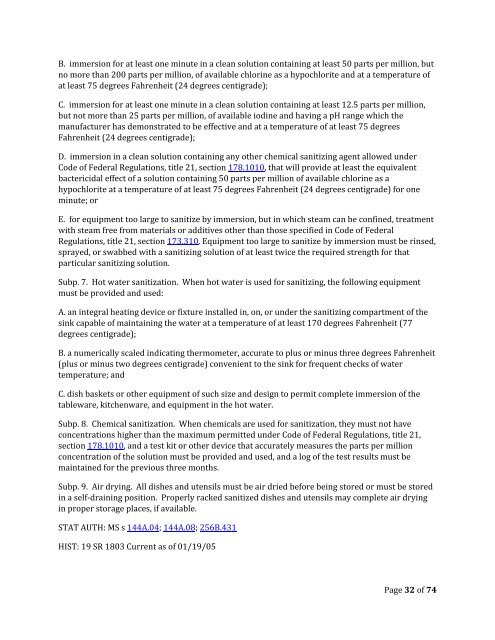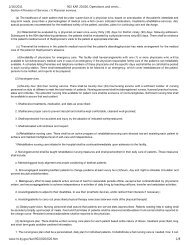State Regulations Pertaining to Dietary Sanitation & Environmental ...
State Regulations Pertaining to Dietary Sanitation & Environmental ...
State Regulations Pertaining to Dietary Sanitation & Environmental ...
You also want an ePaper? Increase the reach of your titles
YUMPU automatically turns print PDFs into web optimized ePapers that Google loves.
B. immersion for at least one minute in a clean solution containing at least 50 parts per million, but<br />
no more than 200 parts per million, of available chlorine as a hypochlorite and at a temperature of<br />
at least 75 degrees Fahrenheit (24 degrees centigrade);<br />
C. immersion for at least one minute in a clean solution containing at least 12.5 parts per million,<br />
but not more than 25 parts per million, of available iodine and having a pH range which the<br />
manufacturer has demonstrated <strong>to</strong> be effective and at a temperature of at least 75 degrees<br />
Fahrenheit (24 degrees centigrade);<br />
D. immersion in a clean solution containing any other chemical sanitizing agent allowed under<br />
Code of Federal <strong>Regulations</strong>, title 21, section 178.1010, that will provide at least the equivalent<br />
bactericidal effect of a solution containing 50 parts per million of available chlorine as a<br />
hypochlorite at a temperature of at least 75 degrees Fahrenheit (24 degrees centigrade) for one<br />
minute; or<br />
E. for equipment <strong>to</strong>o large <strong>to</strong> sanitize by immersion, but in which steam can be confined, treatment<br />
with steam free from materials or additives other than those specified in Code of Federal<br />
<strong>Regulations</strong>, title 21, section 173.310. Equipment <strong>to</strong>o large <strong>to</strong> sanitize by immersion must be rinsed,<br />
sprayed, or swabbed with a sanitizing solution of at least twice the required strength for that<br />
particular sanitizing solution.<br />
Subp. 7. Hot water sanitization. When hot water is used for sanitizing, the following equipment<br />
must be provided and used:<br />
A. an integral heating device or fixture installed in, on, or under the sanitizing compartment of the<br />
sink capable of maintaining the water at a temperature of at least 170 degrees Fahrenheit (77<br />
degrees centigrade);<br />
B. a numerically scaled indicating thermometer, accurate <strong>to</strong> plus or minus three degrees Fahrenheit<br />
(plus or minus two degrees centigrade) convenient <strong>to</strong> the sink for frequent checks of water<br />
temperature; and<br />
C. dish baskets or other equipment of such size and design <strong>to</strong> permit complete immersion of the<br />
tableware, kitchenware, and equipment in the hot water.<br />
Subp. 8. Chemical sanitization. When chemicals are used for sanitization, they must not have<br />
concentrations higher than the maximum permitted under Code of Federal <strong>Regulations</strong>, title 21,<br />
section 178.1010, and a test kit or other device that accurately measures the parts per million<br />
concentration of the solution must be provided and used, and a log of the test results must be<br />
maintained for the previous three months.<br />
Subp. 9. Air drying. All dishes and utensils must be air dried before being s<strong>to</strong>red or must be s<strong>to</strong>red<br />
in a self-draining position. Properly racked sanitized dishes and utensils may complete air drying<br />
in proper s<strong>to</strong>rage places, if available.<br />
STAT AUTH: MS s 144A.04; 144A.08; 256B.431<br />
HIST: 19 SR 1803 Current as of 01/19/05<br />
Page 32 of 74



